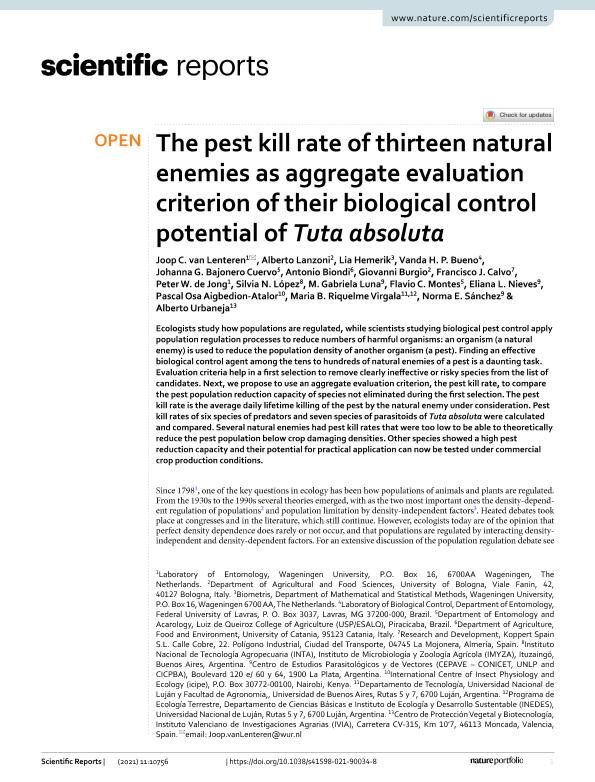Artículo
The pest kill rate of thirteen natural enemies as aggregate evaluation criterion of their biological control potential of Tuta absoluta
van Lenteren, Joop C.; Lanzoni, Alberto; Hemerik, Lia; Bueno, Vanda H. P.; Bajonero Cuervo, Johanna G.; Biondi, Antonio; Burgio, Giovanni; Calvo, Francisco J.; de Jong, Peter W.; López, Silvia Noemí; Luna, María Gabriela ; Montes, Flavio C.; Nieves, Eliana Lorena
; Montes, Flavio C.; Nieves, Eliana Lorena ; Aigbedion Atalor, Pascal Osa; Riquelme Virgala, María Begoña
; Aigbedion Atalor, Pascal Osa; Riquelme Virgala, María Begoña ; Sanchez, Norma Elba
; Sanchez, Norma Elba ; Urbaneja, Alberto
; Urbaneja, Alberto
 ; Montes, Flavio C.; Nieves, Eliana Lorena
; Montes, Flavio C.; Nieves, Eliana Lorena ; Aigbedion Atalor, Pascal Osa; Riquelme Virgala, María Begoña
; Aigbedion Atalor, Pascal Osa; Riquelme Virgala, María Begoña ; Sanchez, Norma Elba
; Sanchez, Norma Elba ; Urbaneja, Alberto
; Urbaneja, Alberto
Fecha de publicación:
12/2021
Editorial:
Nature Research
Revista:
Scientific Reports
e-ISSN:
2045-2322
Idioma:
Inglés
Tipo de recurso:
Artículo publicado
Clasificación temática:
Resumen
Ecologists study how populations are regulated, while scientists studying biological pest control apply population regulation processes to reduce numbers of harmful organisms: an organism (a natural enemy) is used to reduce the population density of another organism (a pest). Finding an effective biological control agent among the tens to hundreds of natural enemies of a pest is a daunting task. Evaluation criteria help in a first selection to remove clearly ineffective or risky species from the list of candidates. Next, we propose to use an aggregate evaluation criterion, the pest kill rate, to compare the pest population reduction capacity of species not eliminated during the first selection. The pest kill rate is the average daily lifetime killing of the pest by the natural enemy under consideration. Pest kill rates of six species of predators and seven species of parasitoids of Tuta absoluta were calculated and compared. Several natural enemies had pest kill rates that were too low to be able to theoretically reduce the pest population below crop damaging densities. Other species showed a high pest reduction capacity and their potential for practical application can now be tested under commercial crop production conditions.
Palabras clave:
BIOLOGICAL CONTROL
,
PARASITOID
,
PREDATOR
,
TUTA ABSOLUTA
,
KILL RATE
Archivos asociados
Licencia
Identificadores
Colecciones
Articulos(CEPAVE)
Articulos de CENTRO DE EST.PARASITOL.Y DE VECTORES (I)
Articulos de CENTRO DE EST.PARASITOL.Y DE VECTORES (I)
Citación
van Lenteren, Joop C.; Lanzoni, Alberto; Hemerik, Lia; Bueno, Vanda H. P.; Bajonero Cuervo, Johanna G.; et al.; The pest kill rate of thirteen natural enemies as aggregate evaluation criterion of their biological control potential of Tuta absoluta; Nature Research; Scientific Reports; 11; 1; 12-2021
Compartir
Altmétricas



